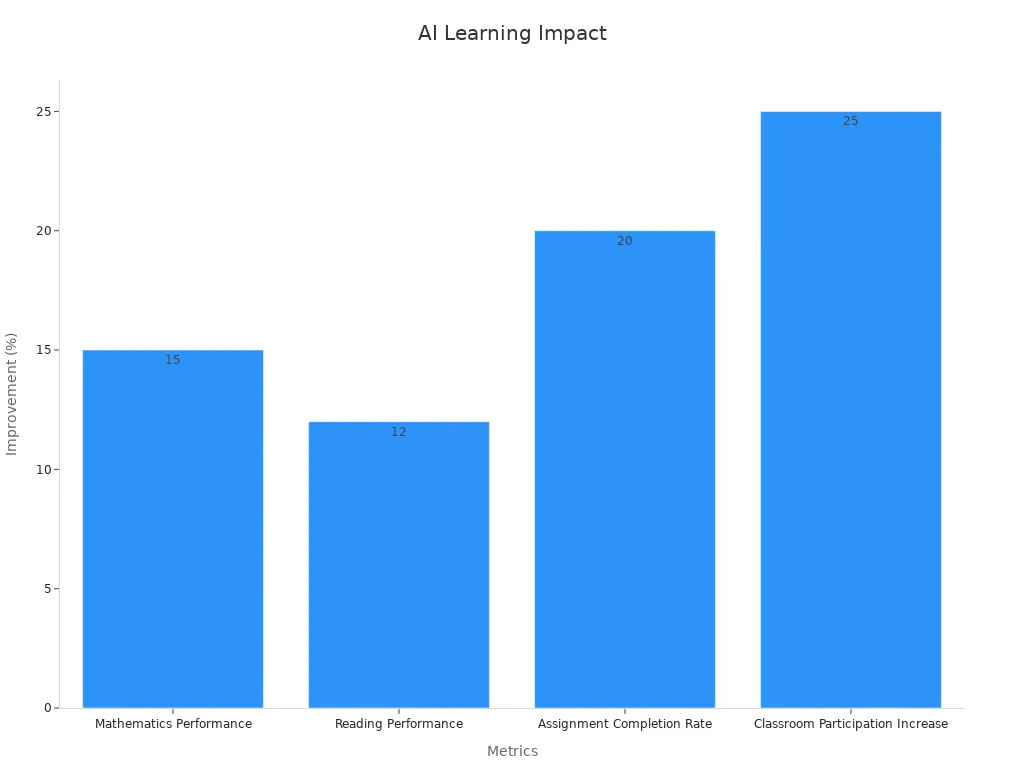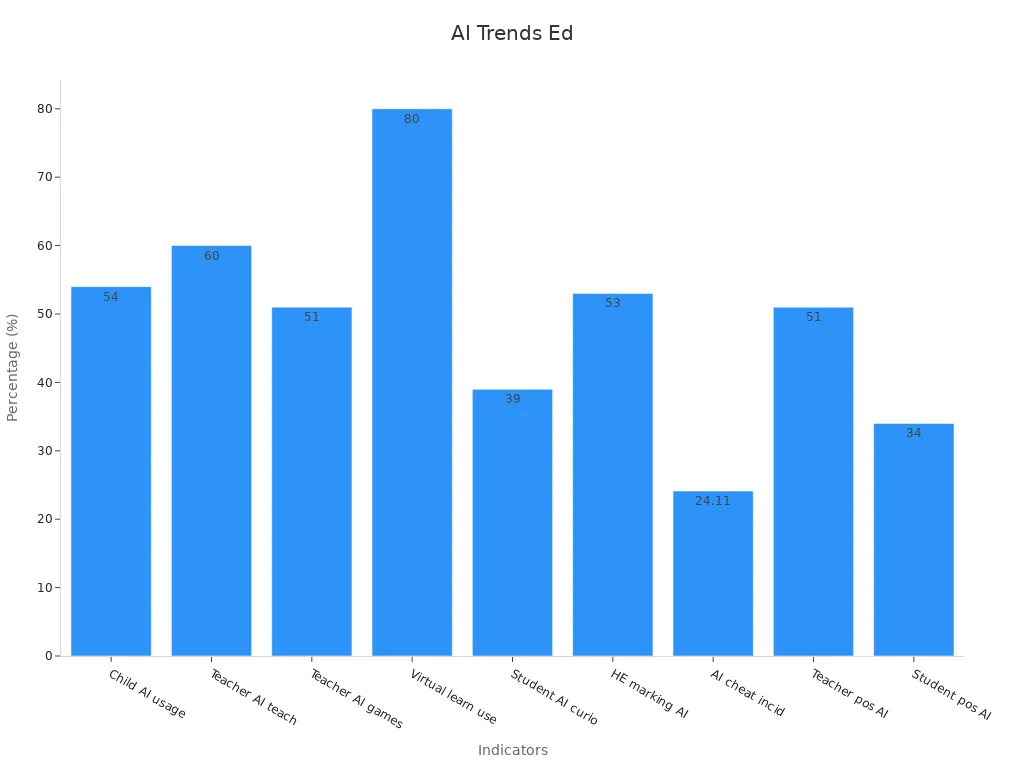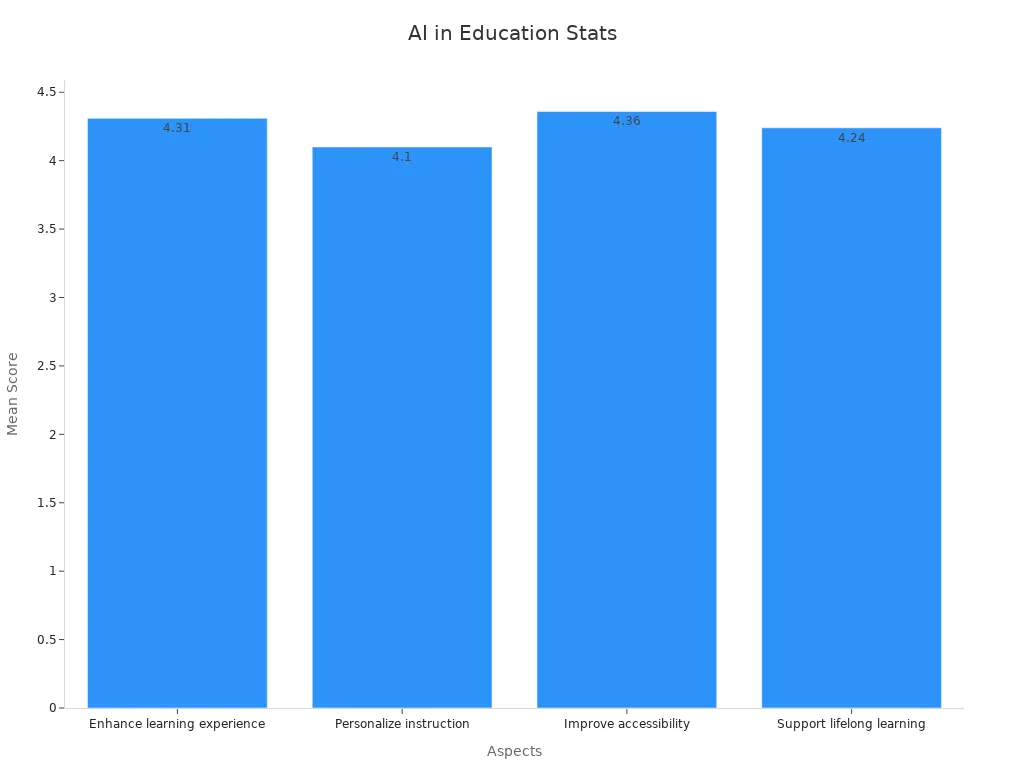
Artificial intelligence is changing education in unprecedented ways. In classrooms worldwide, AI-powered tools have increased student engagement by 67%, offering dynamic and interactive learning experiences. Adaptive platforms now adjust content difficulty instantly, ensuring every student progresses at their own pace. Teachers benefit too, with AI solutions reducing administrative tasks by 32%, allowing more focus on teaching. These advancements make learning more accessible and efficient. Whether through personalized interventions or real-time feedback, artificial intelligence AI is changing education by bridging gaps and empowering both learners and educators.
AI learning tools adjust to your speed, making lessons fun and useful.
Virtual tutors and chatbots are always available to help you learn and stay motivated.
AI studies data to show teachers what you’re good at and where you need help.
AI tools make learning easier for everyone, no matter their needs.
Using AI in school gets you ready for the future and builds important tech skills.
AI-powered learning platforms are revolutionizing how you engage with education. These platforms adapt to your learning pace, ensuring that lessons match your skill level and progress. For example, if you excel in math but struggle with reading, the platform adjusts its content to focus more on improving your reading skills. This personalized approach keeps you motivated and helps you achieve better results.
Recent studies highlight the transformative impact of these platforms. They show a 76% increase in time-on-task, a 34% rise in participation during discussions, and a 28% improvement in course completion rates. These numbers demonstrate how artificial intelligence AI is changing education by making learning more engaging and effective.
Metric | Improvement Percentage |
|---|---|
Increased time-on-task | 76% |
Increased participation in discussions | 34% |
Higher course completion rates | 28% |
By using AI-powered platforms, you can experience a more interactive and tailored learning journey, ensuring that no one gets left behind.
Virtual tutors and chatbots are becoming your 24/7 learning companions. They answer your questions, provide explanations, and even guide you through complex topics. Unlike traditional methods, these AI tools are always available, making it easier for you to learn at your own pace.
Research supports their effectiveness. A study by Yin et al. (2021) found that while students using chatbots achieved similar academic results as those who didn’t, they reported higher motivation levels. Another study by Kamita et al. (2019) revealed that chatbots improved students' mental health by reducing stress and boosting motivation. Additionally, Chen et al. (2023) noted that chatbots enhance learning environments, especially for students from disadvantaged backgrounds.
These tools not only make learning more accessible but also create a supportive environment where you feel encouraged to explore and grow.
AI provides educators with valuable insights that improve your learning experience. By analyzing data such as test scores, attendance, and engagement levels, teachers can identify areas where you might need extra help. This allows them to create targeted interventions that address your specific challenges.
Here are some key types of data AI analyzes to support educators:
Academic Performance Data: Tracks your test scores, course completion rates, and overall progress.
Behavior Data: Monitors attendance, participation, and engagement to understand your learning habits.
Life Skills Data: Includes surveys and well-being indicators to assess non-academic factors affecting your success.
Operational Data: Helps schools allocate resources effectively, ensuring you have access to the tools and support you need.
By leveraging these insights, teachers can focus on what matters most—helping you succeed. This is another way artificial intelligence AI is changing education, making it more efficient and student-centered.
AI has made it possible to customize education like never before. By analyzing your learning patterns, strengths, and weaknesses, AI tools create lessons that match your unique needs. For instance, if you excel in mathematics but find reading challenging, AI platforms adjust the content to focus more on improving your reading skills while keeping you engaged in math. This ensures that you receive the right balance of support and challenge.
The impact of personalized learning is evident in recent studies. Students using AI-driven platforms have shown significant improvements in key areas:
Metric | Improvement (%) |
|---|---|
Mathematics Performance | |
Reading Performance | 12 |
Assignment Completion Rate | 20 |
Classroom Participation Increase | 25 |

These advancements highlight how artificial intelligence ai is changing education by making it more effective and tailored to your needs.
AI is also breaking down barriers for students with diverse learning needs. Tools powered by AI can adapt educational content to suit different abilities and preferences. For example, students with speech disabilities can use AI-driven communication aids to participate in classroom discussions. Similarly, visually impaired learners benefit from AI tools that convert text into speech or provide detailed image descriptions.
Here are some ways AI improves accessibility:
It tailors educational content to meet the unique needs of each student, especially those with disabilities.
It creates individualized learning materials, such as simplified texts or interactive visuals.
It facilitates communication for students with speech or hearing impairments.
These innovations align with policies like the Americans with Disabilities Act (ADA), ensuring that AI is used ethically to support all learners. By addressing these challenges, AI makes education more inclusive and accessible for everyone.
In today’s fast-changing world, learning doesn’t stop after school. AI supports lifelong learning by helping you acquire new skills and stay updated in your field. Whether you’re a student, a professional, or someone exploring a new hobby, AI tools provide personalized recommendations and resources to match your goals.
For example, AI-powered platforms can suggest courses, track your progress, and even simulate real-world scenarios to help you practice. This approach not only keeps you motivated but also ensures that you’re always learning something relevant and useful. By supporting lifelong learning, AI empowers you to adapt to new challenges and opportunities throughout your life.
AI is transforming how teachers manage their workload by automating time-consuming administrative tasks. This allows you, as an educator, to focus more on teaching and less on paperwork. For instance, AI tools can handle lesson planning, grade assignments, and even manage schedules. At the National University of Singapore (NUS), an AI system automates scheduling and course enrollment, freeing up academic staff to dedicate more time to students. Additionally, AI-powered chatbots streamline communication by answering student inquiries about schedules and grades. These tools not only save time but also improve productivity.
Here are some ways AI is reducing administrative burdens:
Optimized class schedules and internship placements.
By automating these tasks, artificial intelligence ai is changing education by enabling teachers to focus on what truly matters—helping students succeed.
AI systems provide real-time feedback that enhances your learning experience. These tools analyze your performance and offer instant suggestions for improvement. This immediate response helps you stay motivated and engaged. For example, AI tools make learning more personalized by showing your progress and highlighting areas where you excel or need improvement.
Evidence Type | Findings |
|---|---|
Engagement | |
Motivation | Instant feedback from AI tools can improve motivation. |
Personalized Learning | Personalized learning experiences can make progress more visible and rewarding. |
Control Over Learning | Students may feel more in control of their learning process. |
Positive Feedback | Very few negative responses (only 2 students) reinforce the notion that AI tools motivate students. |
Learning Efficiency | Many students reported significant improvements in learning efficiency. |
Academic Performance | A significant drop in study hours and an increase in GPA demonstrate effectiveness. |
This data shows how AI-driven feedback improves learning outcomes, making education more efficient and rewarding for you.
AI tools are revolutionizing curriculum design by making it more adaptable and relevant. These systems analyze student performance data to identify what works and what doesn’t. This allows educators to adjust the curriculum in real time, ensuring it meets your needs. For example, AI can customize lessons to fit your learning style, making the content more engaging and effective.
Here’s how AI enhances curriculum design:
It personalizes lessons to match individual student needs.
It automates content creation, allowing teachers to focus on student interaction.
It uses data insights to continuously improve educational materials.
By leveraging these capabilities, artificial intelligence ai is changing education by creating a more dynamic and student-centered curriculum.
AI in education raises significant concerns about data privacy and security. Schools collect vast amounts of personal data, making them prime targets for cyberattacks. Protecting this data is essential to ensure your safety and trust in AI systems. Many AI tools now prioritize privacy by implementing secure infrastructures. For example:
Role-based access controls limit who can view or edit data.
Audit trails maintain transparency by logging all activities.
These measures align with standards like SOC 2 and FERPA, ensuring compliance with strict data governance protocols. However, challenges remain.
The incorporation of artificial intelligence (AI) into education has led to a multitude of questions regarding ethics and data privacy. Despite advancement in modern research and novel techniques being created, lingering concerns remain whether AI education can be completely ethical and have an impeccable data privacy and security system.
To address these issues, schools must adopt privacy-first infrastructures and minimize the storage of unnecessary personal data. This approach reduces risks and ensures that your information remains secure.
AI algorithms can unintentionally perpetuate biases, leading to unfair outcomes. For example, if an AI system uses biased data, it might favor certain groups over others. This can affect your learning experience and opportunities. Developers must actively work to identify and eliminate bias during the design process.
One way to reduce bias is by diversifying the datasets used to train AI models. Regular testing and monitoring also help ensure fairness. Additionally, involving educators and students in the development process can provide valuable insights to create more equitable systems. By addressing these challenges, AI can offer you a fair and unbiased learning environment.
Access to AI tools varies widely between urban and rural areas. Financial disparities often limit rural schools from integrating advanced technologies, creating inequities in educational outcomes.
Evidence Type | Description |
|---|---|
Financial Disparities | Rural schools often lack the financial resources needed for AI integration. |
Professional Development | Teachers in rural areas have fewer opportunities for AI training. |
Leadership Priorities | Leaders must focus on professional development to enhance AI use in schools. |
To bridge this gap, policymakers must prioritize funding for under-resourced schools. Professional development programs can also equip teachers with the skills needed to use AI effectively. By ensuring equitable access, you and your peers, regardless of location, can benefit from the transformative power of AI in education.
AI technologies are evolving rapidly, bringing new possibilities to education. Tools like generative AI are transforming how you learn by creating personalized experiences. For example, AI can analyze your learning data to tailor lessons to your needs. Predictive analytics can forecast your performance and identify areas where you might struggle. These advancements make learning more efficient and engaging.
The global AI in education market reflects this growth. In 2022, it was valued at £2.5 billion, and by 2025, it is expected to reach $6 billion. Over 54% of children now use generative AI for schoolwork, while 60% of teachers integrate AI into their teaching practices. These numbers highlight how artificial intelligence ai is changing education by making it more dynamic and accessible.

By 2025, AI will likely play an even bigger role in education. Experts predict a 31.2% annual growth rate for the AI education market from 2025 to 2030. This growth will be driven by the increasing demand for personalized learning experiences. AI will continue to improve retention rates, engagement, and academic performance. For instance, AI tools have already improved test scores by 62% and increased graduation rates by 12%.
You can expect AI to become a standard part of classrooms, offering real-time feedback and adaptive learning paths. Teachers will rely on AI to design more effective curriculums, while students will benefit from tools that make learning more interactive and enjoyable.
Statistic | Value |
|---|---|
30% | |
Increased student engagement | 54% |
Test score improvement | 62% |
Graduation rate increase | 12% |
To thrive in an AI-driven future, you and your educators must develop new skills. AI literacy will become essential, helping you understand how to use tools like ChatGPT effectively. Schools are already incorporating lessons on prompt engineering and critical thinking about AI-generated content. These skills will prepare you to analyze and refine AI outputs, enhancing your learning experience.
Educators will also shift their roles. Instead of just delivering content, they will guide you in using AI tools to solve problems and think critically. Collaborative learning environments will foster discussions about AI, helping you and your peers adapt to this new era of education.
AI is not just a tool; it’s a partner in learning. By embracing it, you can unlock new opportunities and prepare for the challenges of tomorrow.
Artificial intelligence is reshaping education by making learning more personalized, accessible, and efficient. You can now experience tailored lessons, improved accessibility, and tools that support lifelong learning. A recent report highlights this transformation, with strong agreement on AI's ability to enhance learning experiences, personalize instruction, and improve accessibility.
Aspect of AI in Education | Mean Score | Agreement Level |
|---|---|---|
Enhance learning experience | 4.31 | Strongly Agree |
Personalize instruction | 4.10 | Strongly Agree |
Improve accessibility | 4.36 | Strongly Agree |
Support lifelong learning | 4.24 | Strongly Agree |

To maximize AI's potential, addressing challenges like data privacy, bias, and equitable access remains essential. The future of education depends on how effectively artificial intelligence ai is changing education to empower both students and teachers.
AI makes learning more personalized. It adapts lessons to your strengths and weaknesses, helping you learn at your own pace. This approach keeps you engaged and improves your performance. AI also reduces teachers' workloads, allowing them to focus more on teaching and supporting students.
AI tools support diverse learners by offering features like text-to-speech, speech-to-text, and visual aids. These tools help students with disabilities or language barriers access educational content. For example, AI can translate lessons or simplify complex texts, ensuring everyone has equal opportunities to learn.
Most AI tools prioritize data security by using encryption and access controls. Schools also follow strict privacy laws like FERPA to protect your information. However, you should always use trusted platforms and avoid sharing unnecessary personal details to stay safe.
AI cannot replace teachers. It serves as a tool to enhance teaching by automating tasks and providing insights. Teachers guide, inspire, and connect with students in ways AI cannot. The future of education relies on collaboration between teachers and AI.
You can prepare by learning how to use AI tools effectively. Focus on developing skills like critical thinking, problem-solving, and adaptability. Schools are already teaching AI literacy, helping you understand how to analyze and refine AI-generated content. These skills will help you succeed in an AI-driven world.